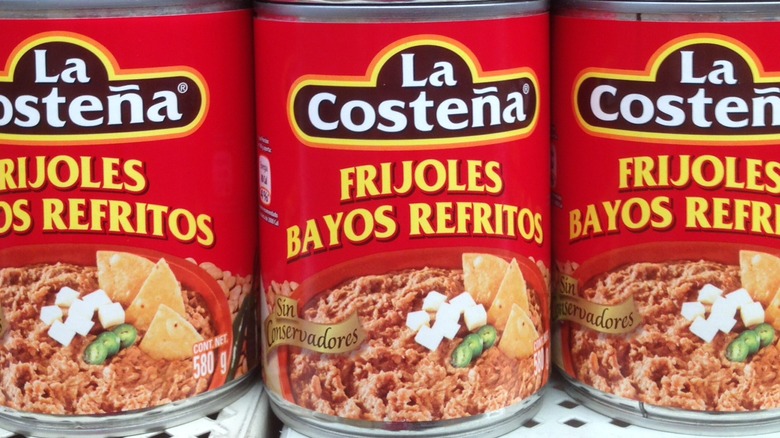The Best Way To Freeze Canned Refried Beans
You can do a lot with a can of refried beans. If you're short on ingredients, just add a pot of rice, and you've got dinner ready in a flash — and a hefty serving of protein to boot. These incredibly versatile legumes are also right at home in a dip, tucked into nachos, or mixed with ground beef and rolled into taquitos. They often come in a 16-ounce can, however, which is more than many recipes require. But you don't have to get creative to come up with a way to use leftover canned refried beans, because they're easy to freeze and can last for a long time.
The next time you have extra refried beans on your hands, all you have to do is load them into an airtight container or freezer bag. Before you do this, first make sure that the beans are cool; if they're hot when put in the freezer, ice crystals can form, causing freezer burn and messing up the texture of the beans. Next, remove all (or as much) of the air as possible. The less air inside the container, the less chance the beans have of getting freezer burn. Adding a little olive or avocado oil to the beans before you seal the container will create a barrier between the beans and any lingering air, plus the oil will help keep the beans nice and moist when it's time to defrost. Finally, label and date the container, and put it in your freezer.
Air is the enemy of frozen canned refried beans
Beans are resilient little vegetables, because not only can they stand up to hours in a slow cooker, but they can also hold their own in the freezer. If stored properly, refried beans will look and taste nearly the same as they did coming out of the can, as long as you're careful to prevent the dreaded freezer burn. Freezer burn happens when the outer layer of frozen food loses its moisture. Beans are typically starchy and dry — and refried beans are even drier, a result of losing moisture during their long cooking process — which means beans are especially susceptible to moisture loss.
Also, it's not a great idea to refreeze beans after they've thawed, because refreezing will make them get too dry and grainy. That's not to say that you should never freeze, thaw, and then refreeze canned refried beans. Just keep in mind that doing so will degrade the texture of your beans. Try to only freeze them once or twice, and if you absolutely must freeze them again it's best to do it only when the beans are mixed into a recipe like bean and cheese burritos. That way your beans will be combined with other wet ingredients, which will help to keep them moist.
Freeze leftover refried beans in small, labeled containers
Before you freeze all your refried beans in one bag, consider most recipes only call for a small amount of beans (which is probably why you have leftover canned refried beans to freeze in the first place). So instead of reaching for the quart-sized freezer bags, grab the snack-size bags and freeze your leftover refried beans in smaller portions. Try freezing them in ¼-cup increments, which will make it easy to calculate what you need when the next refried bean-worthy occasion arises. That way, when taco night rolls around you can thaw out only what you need and save the rest for another meal.
Be sure to label and date each bag or container before you put them in the freezer. Refried beans will stay fresh in your freezer for at least three months, but they'll start to dry out even under the best conditions if you don't use them in that time. Plus, it's easy to misplace a small bag of beans only to find them several months later hiding behind a bag of peas. Knowing how long they've been lurking unseen lets you know if they can be thawed and eaten, or should be tossed out.


